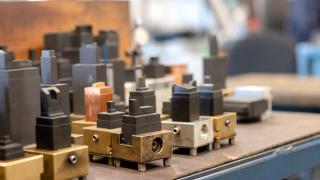
Injection moulding has been a key part of the manufacturing process for years now. Having such a history means that we’re reliant on its ability to produce the intricate products that we need on a day-to-day basis. Whether it’s a tooling process, promoting precision in the world of manufacturing, or creating a one-of-a-kind item that’s tailored to a specific machine, the go-to operation is injection moulding. But, with all its uses, are we making sure that it’s a sustainable process that supports an eco-friendly future?
What Exactly is Injection Moulding?
Injection moulding is one of the most common processes in manufacturing.
Injection moulding is one of the most common processes in manufacturing. It’s simply a process in which a material is melted down to a viscous state. The materials are most commonly plastics and metals, which are then injected into a product mould. The mould will usually be made of something stronger than the product material to ensure it doesn’t deform and melt. It’s then left to cool and taken out of the mould. It’s that simple!
What is Injection Moulding Used For?
Injection moulding is used to create much more than you’d initially think. It could be anything from the dashboard of your car to the disposable razor that you use in the mornings and even the syringes that hospitals use.
Injection moulding acts as one of the most widely used manufacturing processes and yet, it’s one that very few people know about. It’s not a process that excites people in the same way that 3D printing does.

READ: Injection Moulding - Present and Future
Is Injection Moulding Already Eco-Friendly?
While there is a slight misconception that the manufacture of plastic products are bad news, injection moulding is relatively eco-friendly as it stands today. This is due to the fact that if the process is planned out correctly and executed in the right way, the impacts are minimal.
Recyclable Materials:
The majority of the materials used in the injection moulding process can be reused to ensure that there is little waste, which is ideal. If done correctly, there won’t be a lot of waste, if any but in the event of scrap, these leftovers can be reused and moulded into other products. An example of this would be the trimmings, gates and runners of the mould/ product. These can be reground and melted again if necessary.
Injection Moulding Machinery:
The machinery used in the injection moulding process is efficient enough to help cut costs and lower emissions. Often the machinery is designed to do the job as efficiently as possible, meaning that they use as little electricity as possible to achieve the same products.
There are a few different styles of injection moulding machinery - hydraulic, all-electric and a hybrid of the two. The hydraulic machinery does require a lot of power in order to run, however, after the introduction of the all-electric machines, the power consumption dropped dramatically and so the impact upon the environment lowered too.
Waste:
Injection moulding waste is something that has been on people’s minds for a long time. However, the aforementioned reusing of these small waste products means that we’re able to cut the waste products and throw away less too.

How Could Injection Moulding Be Greener?
Solar Power
If an injection moulding company were to install solar panels on the roofs of their factories, they’re more likely to have a smaller impact upon the environment. If these companies were able to produce enough power to cover the consumption of their machinery, that would be ideal. They’d be self-sustaining and wouldn’t have to pull power from the grid.
Even if the companies aren’t able to completely cover their power usage, they would still be making sure that their use is cut down and has less of an impact upon the environment.
Injection Moulding Wastage
The idea that we could cut waste from the injection moulding process completely might not be widely accepted and it isn’t always possible. But trying to make sure that you’re reusing the wastage from a previous mould is good practice.
That previously-used plastic won’t be affected by the melting process and is perfectly fine to use again. This means that if the prototype isn’t right, you can always melt it down and start again. This would allow the process to use less plastic and become as efficient as possible.
Updated Machinery
We can see there is always room for improvement, and we should be looking to lower our carbon footprint as much as possible.
Due to the ever-developing nature of our world, it wouldn’t be unexpected to think that the technology that injection moulding is built upon could dramatically change and offer a more efficient, cost-effective way to produce products. While injection moulding is already very cost-effective, there is always room for improvement and so if it could be done, we’d welcome it with open arms!
In doing this, we’d be able to offer our services for less and create better processes and products for our clients.
In summary, we can see there is always room for improvement, and we should be looking to lower our carbon footprint as much as possible. In turn, we should be trying to decrease the amount of waste we’re producing too. We do have a responsibility to our planet and the future generations, which means that we should be thinking about how we can help them and secure their future. This might mean that the misconception of all plastics being awful is something to be addressed or it might mean that we should all be pushing for solar power and clean energy to become a more mainstream focus.
- Kerry Beeby, Pro Moulds - www.pro-moulds.co.uk
--
Pro Moulds are expert toolmakers and tool repairs specialising in injection moulding and laser welding in the UK. Based in Nottingham, they’re ideally located to cover nationwide so call us on 01623 904 417 or visit www.pro-moulds.co.uk.